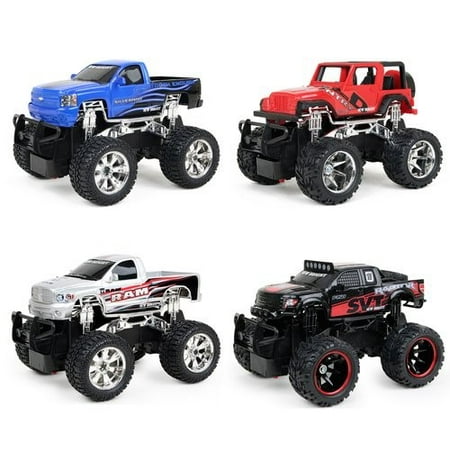Best Choice Products Set of 2 1/18 Scale RC Remote Control Transforming Robot Sports Car Toys w/ 1 Button Transformation
TWO 1/18 SCALE RC CARS: 2.4Ghz remotes have controls for forward/reverse and left/right movement, plus buttons for auto-drive and transformation. Separate frequencies of 27MHz and 49MHz allow both cars to be used at the same time.ONE-BUTTON TRANSFORMATION: 2-in-1 toy gives kids the best of both worlds; simply press and hold a button to switch from a slick sports car to a powerful robot in just seconds!360-DEGREE DRIFTING ACTION: Performs full, 360-degree turns in both car and robot mode, so it can spin and twist with near limitless mobilityENTERTAINING LIGHTS & SOUNDS: Interactive features include engine and acceleration sounds and drifting LED lights under the car to keep your kid engaged while they play3MPH MAX SPEED: Cruises across carpets and pavements at 3 miles per hour for a safe yet fun experience; NOTE: Packaged individually so they can be given as separate giftsDIMENSIONSBox Dimensions: 14″(L) x 5.5″(W) x 4″(H)Robot: 6.75″(L) x 5.75″(W) x 7.75″(H)Car: 9″(L) x 3.75″(W) x 2.5″(H)Remote w/o antenna: 4.75″(L) x 2″(W) x 4″(H)Remote w/ antenna: 4.75″(L) x 2″(W) x 11″(H)Weight: 2.2 lbs.SPECIFICATIONS:Material: ABS PlasticRemote Control Frequencies: 27MHz, 49MHzRobot Battery Type: (3) AA (not included)Remote Battery Type: (2) AA (not included)Max Speed: 3 mphRecommended for ages: 2+ yearsIncludes: (2) Transforming RC cars, (2) Remote controlsNo assembly requiredASTM-certifiedBCP SKU: SKY5463







TWO 1/18 SCALE RC CARS: 2.4Ghz remotes have controls for forward/reverse and left/right movement, plus buttons for auto-drive and transformation. Separate frequencies of 27MHz and 49MHz allow both cars to be used at the same time.ONE-BUTTON TRANSFORMATION: 2-in-1 toy gives kids and children the best of both worlds; simply press and hold a button to switch from a slick sports car to a powerful robot in just seconds!360-DEGREE DRIFTING ACTION: Performs full, 360-degree turns in both car and robot mode, so it can spin and twist with near limitless mobilityENTERTAINING LIGHTS & SOUNDS: Interactive features include engine and acceleration sounds and drifting LED lights under the car to keep your kid or child engaged while they play3MPH MAX SPEED: Cruises across carpets and pavements at 3 miles per hour for a safe yet fun experience; NOTE: Packaged individually so they can be given as separate gifts; BOX DIMENSIONS: 14″(L) x 5.5″(W) x 4″(H); Recommended for ages: 3+ years





Reviews
There are no reviews yet.